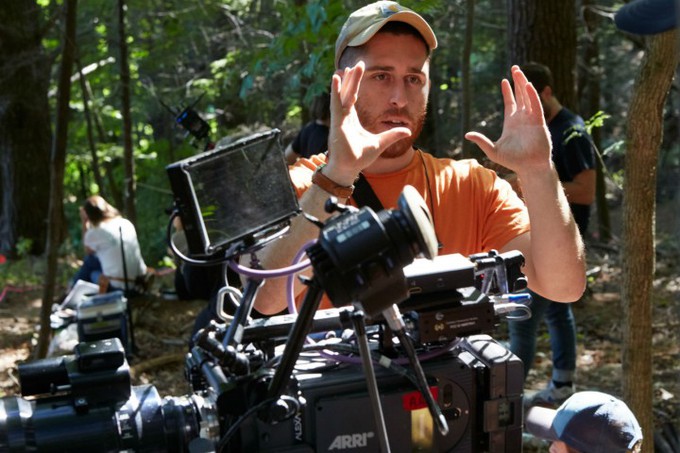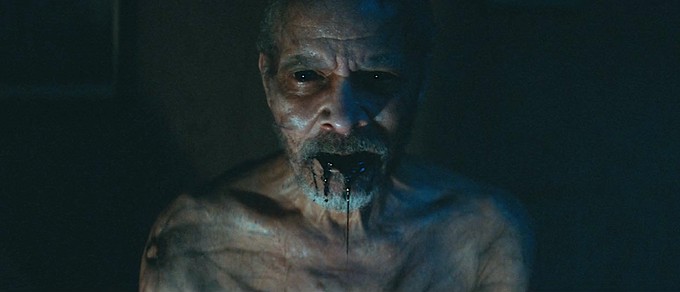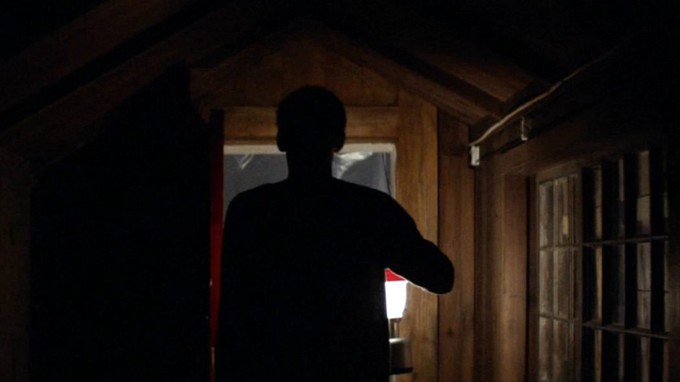Ahoy, squirts! Quint here. A few weeks back the good folks at the Alamo Drafthouse did a big screening of IT COMES AT NIGHT where they bussed a ton of people out in the middle of nowhere Texas countryside where we were met with folks wearing gasmasks holding up lanterns, guiding us to a giant outdoor screen next to a roaring fire with a body shape in the middle of it. That's how they do.
Director Trey Edward Shults was along for the ride, giving a Q&A after the movie and sitting down with some of us press people the next day. The movie began as Shults' way of dealing with the death of his father, a thought impossible to shake when watching the film. The whole first scene is characters saying goodbye to a member of the family who contracted a disease that has wiped out much of humanity.
Shults and I talk a bit about this personal connection as well as the structure of the writing and how he used cinematic technique to build tension through this tale of simmering paranoia. I think it's a pretty illuminating chat. Hope you guys enjoy it!

Quint: So, how'd you enjoy the big outdoor screening last night? That must have been an interesting way to watch your own movie.
Trey Edward Shults: It was very surreal. I didn't watch the movie, I just went over to the fire where the body was burning and had some beers. I would check in every now and then, but it was very surreal just seeing buses of people going out into the woods.
Quint: Did check in to see how any particular moments played with the crowd?
Trey Edward Shults: I would literally lean over to see where we were in the movie and catch some (glimpse), but I still haven't fully sat down and watched the movie with an audience. I guess I did it once with a test screening, when it was a way rougher cut, and I drank before and I started sobbing uncontrollably at the end. I think because the movie's so personal that combined with exhaustion just made me a wreck.
I think I'm going to watch it in this small little premiere we're doing in New York with my mom. I'm going to hold her hand, watch it and probably cry again.
Quint: It's not the kind of movie that elicits a big, vocal audience response.
Trey Edward Shults: It's a quiet movie.
Quint: Right. There's not a lot of jump scares or tension-relieving laughter, so I can imagine it'd be rough to get a read on the audience while you're in it.
Trey Edward Shults: Exactly. It was the same with my last movie, Krisha. Krisha had a little bit of humor at the top, but the movie is brewing on every person individually, so you don't really know. You can't gauge it easily like a big comedy or with jump scares. But I still do want to watch it with an audience because you feel a different energy seeing a movie through fresh eyes. It might sound weird.
Quint: I know exactly what you're talking about. It's a little different, but I've been rewatching movies with my nephews over the last couple of years and seeing them fresh through their eyes. There's definitely a tangible difference doing that. I felt it pretty strongly when I showed the older nephew Carpenter's The Thing recently.
Trey Edward Shults: Did he flip out?
Quint: He loved it, yeah.
Trey Edward Shults: I saw The Thing at a young age, too. It's one of my favorite films.
Quint: So, I get what you're saying from a conceptual point of view. I'm sure it's much different when you have such a deep, personal connection to your own film.
Trey Edward Shults: It is, but I will say the other way is much more enjoyable! I would love to watch The Thing through fresh eyes. That sounds amazing. With your own movie it's weird because you have your own insecurities and you know it better than everyone else... it's a messy, weird thing.
Quint: There's also two movies that exist for you: the perfect version in your head and the one that actually exists on the screen.
Trey Edward Shults: Exactly. That's the weirdest thing.
Quint: You've talked a lot about how you began this project as a way to deal with your father's death. I won't ask you to repeat that story, but I'd like to get into the craft of writing your screenplay. It's one thing to have a creative outlet for your grief, it's another to turn that into a fictional story that is structured and thematically consistent.
Trey Edward Shults: Totally.
Quint: Can we start by talking about the structure? I really enjoyed how you seeded in these landmarks of horror throughout a small story about paranoia via the nightmares. Every so often you get a jolt of horror with the nightmares of Kelvin's character. Was that structure something that came early on or did you have to work at finding those moments?
Trey Edward Shults: I think it was throughout. Honestly, I feel like with this movie the writing wasn't done until the edit. A lot of things are left unsaid and whatnot, but even just the structure of reality vs nightmare... theoretically you can place those things wherever you want. There was certainly finagling and tweaking and changing that went on into post, past the writing phase.
With the writing, for starters what it was the kind of storytelling I like, where you're just kind of thrown into it and you're playing catch up. I did the same thing with Krisha. I just like throwing you into a situation and you're slowly playing catch up. The nightmares I used more as a character thing, getting to know Travis and what is going on in his head. Each one is confronting a different thing.
Quint: I very much picked up on that. His first nightmare is about his grandpa, he has a nightmare about losing the dog and a nightmare about his attraction towards the new woman, etc. I appreciated that you used the sequences to show character and not tell us character.
Trey Edward Shults: I love visual storytelling. I'd love to be able to figure out a movie with almost no dialogue. It's fun when contemporary movies do that, like the first 20 minutes of There Will Be Blood and Under the Skin does that a lot.
Quint: Now, I'm happy with the movie and wouldn't tell you change it, but I was wondering after the movie ended if you ever had a desire to make the plague more of a mystery. Does it really exist? Are these people crazy? You don't go that route. Your opening scene is the results of this disease. You chose to focus on the paranoia, not the mystery of a potential twist. I was thinking specifically of Take Shelter, where that reveal at the end is such a whopper and I knew you worked with Jeff Nichols. I don't think this story is set up to work as well, but was there ever a temptation to go that route and give the film a big reveal?
Trey Edward Shults: I love that movie. It's so great. But no, this movie always started with the grandpa at the beginning. This man is sick, he's dying. It started with the personal stuff for me and as I kept writing it became apparent that I'm not interested in whether this disease is real or not. It is and that's just how it is. What I am interested in is what it does to the characters, the fear it instills in them and the dynamics between them because of it. It was always clear that the disease is real and it's what they're all afraid of.

Quint: The biggest takeaway of the movie for me was watching your technique. As a genre fan I had to endure so much found footage stuff for so long which by its very nature restricted cinematic technique that I'm happy to see it alive and well. You use the the sound design, cinematography and patient editing to really build a palpable tension. How important was that to you to put at the forefront?
Trey Edward Shults: I will say genre-wise I didn't really think about it differently. I wasn't like “because this is a horror movie I'm going to do it this way.” I don't even know if I see this as a horror movie. It's just my movie. Even Krisha, which I made for $30,000 at my mom's house, I wanted to feel like a movie, I wanted it to feel cinematic. Film grammar and technique is so hugely important to me. I'm obsessed with it. I don't even know where to begin, but especially for this movie it's very, very important. It's going to be that way with any movie I make.
Quint: Can you talk specifically about building tension? There's always a feeling of unease, which even big studio movies with all the resources in the world can't always capture. So, what's the secret?
Trey Edward Shults: It's everywhere in this movie. The filmmaking process... it comes from so many different aspects. It starts with the writing. These are real characters and there are stakes. The stakes are life and death. Hopefully you care about these people. From that simple life and death set up with real stakes you get so far.
Then it goes to how you film a scene. Do you cut? Do you not cut? Do you cut out the sound? I think a lot of the movie is really quiet and minimal, but when we hit we really hit and we go for it. I love that. It's every single aspect from how you write it to how you shoot to the sound. I don't know... I'm not good at being specific!
Quint: I'll say one specific choice you made that really cranked up the tension: you chose a very long, narrow hallway that leads up to the big red door that is the only thing that separates our characters from the danger outside.
Trey Edward Shults: Totally. And we even played with aspect ratio throughout the movie. I hope that adds tension. All the nightmares are in a different aspect ratio. Subtly it goes from 2.35 to 2.60 and then 2.70 and at the end of the movie, all throughout the climax where the two families are falling apart, the screen is slowly compressing until after the thing happens... sorry, don't want to spoil it... but it goes to 3.0 and stays like that for the rest of the movie. We also go handheld for the first time. That stuff I loved, too. All these tools we have at our disposal and we used them. The shot in the hallway, the first time we transition to nightmare world the black bars shrink in on you as you go close to that door. It's everything.
Quint: How much of that kind of stuff did you figure out in advance and how much did you figure out on the fly?
Trey Edward Shults: That's a good question. Probably 80-85% in advance. We had a hard game plan, but we always wanted to be open to something even better. You never know. That happened a lot with my DP and I. We'd have a hard-set thing and as we get inspired by a location or something else it totally changes. That continues in the edit. It's always about making it as effective as it can be.

There you have it. I have a feeling that Shults is a name we'll be hearing a lot of in the coming years. He's exactly the kind of young director the studio system likes to pluck for their big movies. He's a natural with cinematic language and can build tension with an ease that makes me think he'll be on the radar of just about every production exec in Hollywood once they see this movie.
Hope you guys enjoyed the interview! It Comes At Night is out this weekend!
-Eric Vespe
”Quint”
quint@aintitcool.com
Follow Me On Twitter

